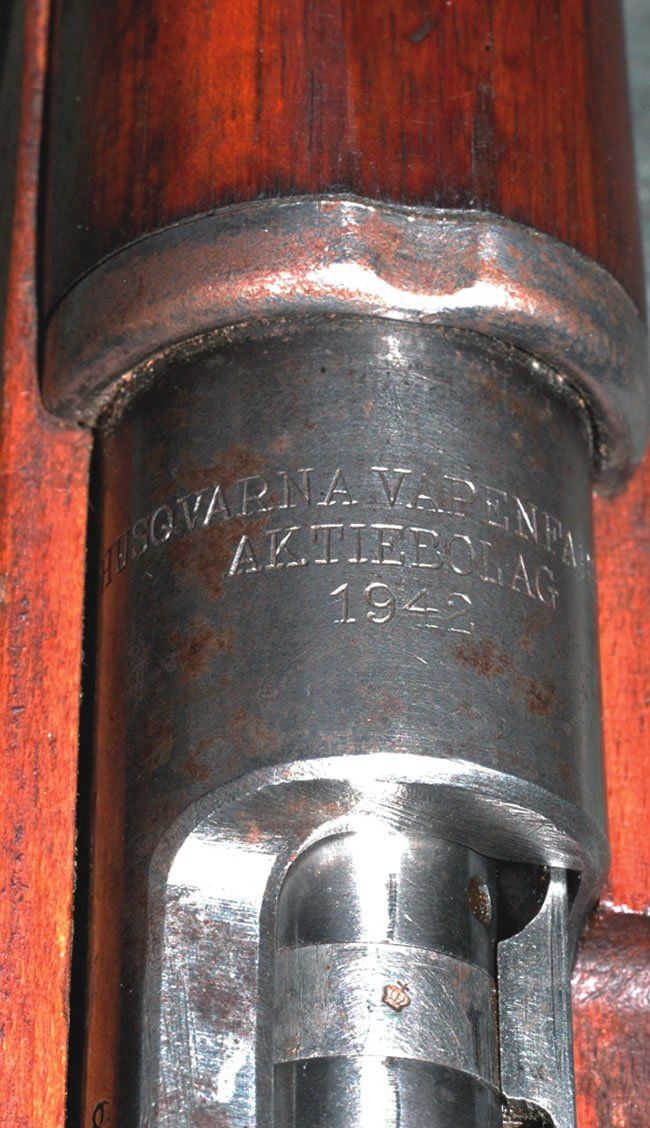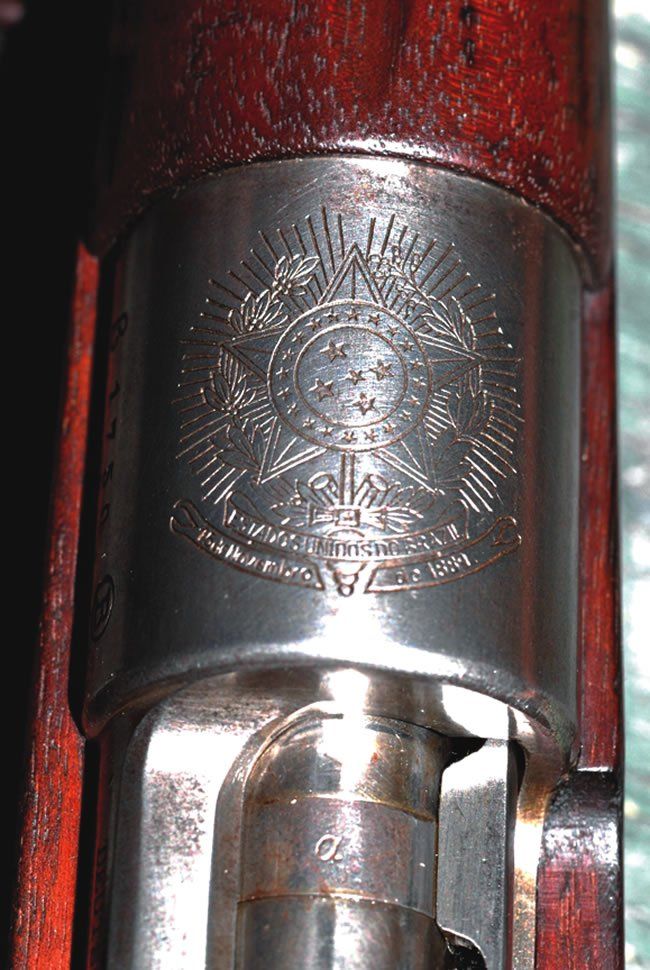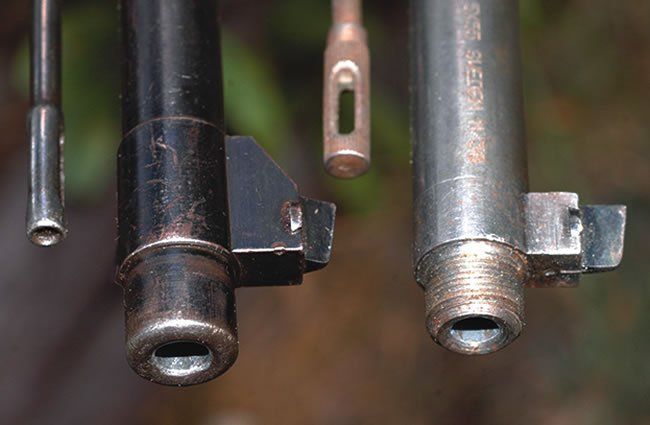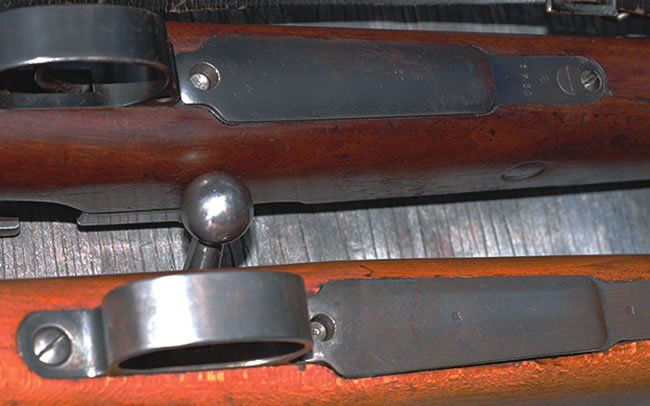
Older Mauser rifles are getting scarce. We used to be able to pick them up for a song, well under $100 in recent memory, but no more. Our Idaho test team recently had a chance to examine and shoot two old surplus Mauser rifles in standard military configuration, one a Swede M38 bearing the Husqvarna stamp on its ring (about $500), and the other a Brazilian 1908 DWM M98 in 7×57 (about $450) — or about five times what they used to cost — and these were far from perfect.
The 1908 DWM M98 was one of the longest rifles we’ve tested, with its 29.2-inch barrel. The Swede, in 6.5x55mm Swedish, had a decent birch stock and a more reasonable barrel length. We shot them with Remington ammo (both calibers) and a variety of other types. A reader suggested we be sure to try non-U.S. ammo in the Swede. We had some Swedish surplus on hand, so we were able to do that. Here’s what we found.
Husqvarna Mauser Model 38
6.5x55mm Swedish, $500
One of the first Mausers adopted by Sweden was called the Model 96, which later got truncated and lightened into our test rifle, which was then renamed the Model 38. Considered a small-ring Mauser, the Swede has an extended cocking piece with checkering on top. In front of that is the standard turn-over, wing-type safety. The Swedish Mauser cocks on closing, which means the final inch of closing the bolt is done against spring pressure. The follower of our test rifle had not been altered, so the bolt would not slip closed on an empty chamber. That’s of course a wartime expedient to make sure the soldier knows when to reload in the heat of battle. The wood of our test rifle was birch, and in very good condition. The grooves in the forend and a few other places on the stock were dark, indicating the wood had been at some time refinished, leaving behind some of the old dirt. There were no significant markings on the stock save for a “T” on the left side of the stock near the finger groove for stripper-clip loading. There was also an insert on the right butt-side, which indicated barrel and throat wear. This barrel was marked a “3” and should be replaced.
The metal was mostly in the white, which means there was severe bluing wear throughout. Actually, some of the parts looked like they had never been blued, while others clearly had bluing worn extremely thin. The white metal showed signs of incipient rust in many places. The floorplate was particularly bad. The barrel was tapped on its end for a flash hider, but was missing any sort of protective cap. The action ring had the Husqvarna name and a date of 1942.
The rifle was relatively clean outside, but its barrel was a mess. We cleaned it as well as we could, but had no great hopes for its accuracy. The trigger was a common military two-stage item, with a clean break on the final part, though a touch heavy. The sights consisted of a rear U-notch adjustable to 600 yards, and it had a clever idea incorporated. If you flipped it up 90 degrees, you can see the yardage markings repeated on the bottom, so the soldier could make adjustments without taking the rifle down from the shooting position, or without exposing his head to look at the top of the sight. The front blade was in a dovetail and was essentially unprotected. It had a flat top, which was an improvement over the common German pointed-top front sight for determining elevation.


All in all we thought this rifle needed a thorough disassembly and cleaning to make all its parts work better, especially the sight adjustments. We left that for the owner, who kindly loaned this to us as soon as he got it. All the numbers we found matched on this rifle, so it would be a good representative of the type if it were fully cleaned up. Many collectors have no interest in shooting their collectibles, so they tend to ignore the condition of the inside of the barrel. We think that’s a mistake, because the heart of any rifle is its barrel. If that’s neglected and generally in poor condition, we would not rate the rifle highly even though the outside looked like new. That’s our two cents.
As for ammo, there is no shortage of it available for this caliber, and we had Remington, Hornady, and some Swedish surplus with steel-jacket bullets. This latter ammo looked quite nasty in the box. As it turned out, it gave reasonable groups, but bolt lift was hard, most likely from the poor condition of the cases. The hot Hornady ammo got much higher velocity and gave zero sticky bolt lift, and also gave us the best accuracy. Smallest group was 1.1 inches, and average was 1.6. There were no problems with the rifle, though ejection was generally not very strong, no matter how hard we worked the bolt.
Our Team Said: Overall, the rifle had little to recommend it, though accuracy was acceptable with the Hornady ammo. It worked all right and the stock condition was somewhat above average, but the overall condition of the rifle was certainly not outstanding. We thought this rifle deserved a C grade.
Brazilian 1908 Mauser 98
7×57 Mauser, about $450
This was one long rifle, yet it had a balance that was entirely missing from the Swedish Mauser. Despite its length and weight, it felt handy, and was easy to hold for offhand work. The exterior of the rifle was in great shape. The bluing was mostly intact, though worn thin on the action. On the barrel, the bluing looked entirely undamaged, and was nearly as good on the floorplate and trigger guard. Once again, all the numbers we found were matching. The action ring had a five-pointed star and the full name of Brazil in a very decorative, clean stamping. Down on the right side of the front ring was “Mod. 1908.” The left side of the action identified this as a DWM Mauser action. The overall workmanship, wood and metal, appeared to be far superior to that of the Swedish rifle. The sights were normal mil-spec Mauser, with a V-notch rear and pointed front, with the rear sight regulated from 300 out to 2000 yards. The straight-handle bolt closed even with the action empty, the result of someone knocking off the rear of the follower. The work appeared to have been professionally done, and may have been part of the Brazilian specifications.


The wood was dark walnut, not at all dented or badly scratched. It had some decent grain that many a sporting rifle would have liked to have. There was a numeral 22 painted on the left side of the butt, and the right had not only a metal escutcheon inletted, but also a six-pointed star within a circle stamped into the wood. The center of the star had the letter “B.” A thick, wide, leather sling came on the rifle. It had seen better days. It was rough, stiff, rubbed and raw, and was about ready to break. We’d zing it if we owned this one. The only interest there was in the rear attachment point, which appeared to be some sort of quick-removal mechanism. Unfortunately, it was bent beyond use.
We thought we had a real winner here. Then we looked through the barrel. It was like looking through a dark, dirty stovepipe. What a pity. A diligent cleaning did very little good for the barrel. Again we wondered why so many caretakers of this rifle over the years never gave a thought to the barrel innards.
We took the rifle to the range, and as always, shot one from 25 yards to make sure the rifle was on the paper. The round struck 2 inches low, so we considered it okay to try from 50 yards off our machine rest. We had two types of ammo. One was Remington 140-grain Core-Lokt, the other, Federal 175-grain soft points. We fired a round of the Remington and looked long and hard at the target through our old Bushnell Sentry 20x spotting scope for the hole. Nothing. Okay, we thought, it struck low on the 25-yard target, so we’ll try another shot a bit higher on the paper.
Our target was about 2 feet square or a bit more. The second shot again produced no bullet hole. Somewhat dismayed, we went to the 25-yard line on a bigger paper target and fired three shots. We got a 9-inch group at 25 yards. We then tried the heavier bullet load and got a group of 7 inches. We concluded this rifle was a total loss for shooting, and never fired another shot, except to get chronograph results. Feed, function, and ejection, for what it’s worth, were all excellent and the trigger was very much acceptable.
Our Team Said: Here’s a perfect example of a “collector-grade” firearm with generally excellent cosmetics, but with a completely useless barrel. If some poor soul has the time and interest to grind away at the barrel with mild abrasives to get the soot and other crud out of it, this rifle might be made to deliver some of its shots onto the paper at 50 yards. But if you find one in similar condition, we’d just walk away.
Written and photographed by Ray Ordorica, using
evaluations from Gun Tests team testers. GT


























I love the idea of these tests generally, but feel this is a good example of a one where the results are extremely specific to the rifles you handled. And testing rifles with terrible bores is not very helpful to readers. Those who might be interested in acquiring one hopefully know enough not to get (or shoot) a rifle with a bore in poor condition. By contrast, testing good examples of these rifles would be much more interesting because it would give the reader a sense of what they are capable of if they likewise find one in good condition. They don’t need to be collector grade, and some bore wear is OK, just good enough to illustrate their potential.